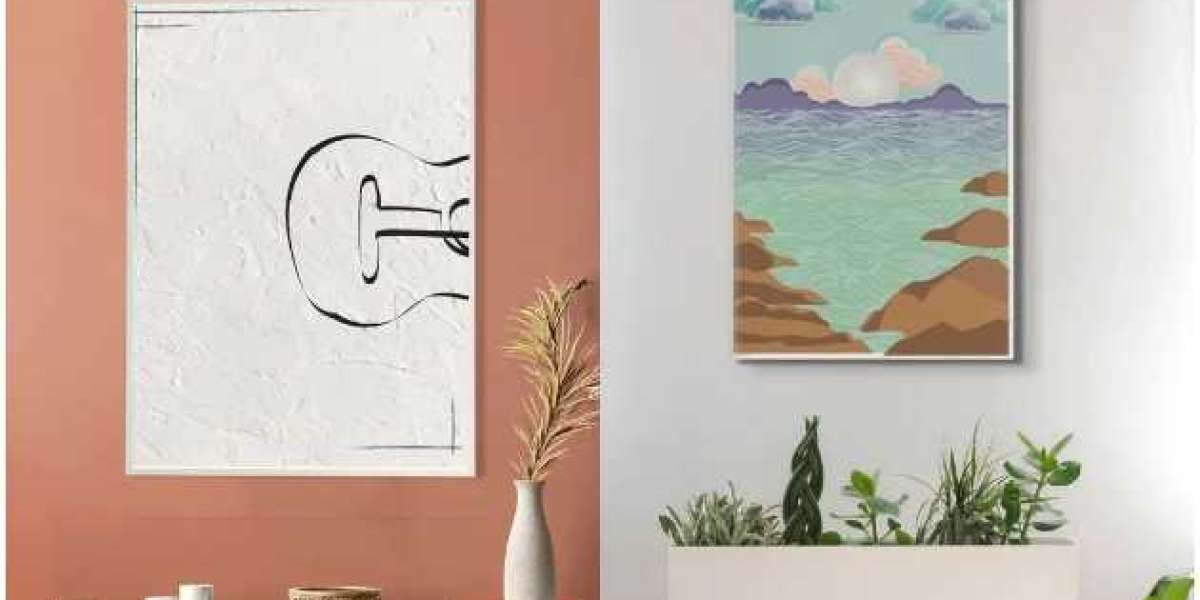Choosing the right wall painting images for your space can significantly enhance the ambiance and aesthetic appeal of your home. Whether you are decorating a bedroom, living room, or hall, selecting the perfect wall art painting can make all the difference. In this comprehensive guide, we'll explore tips and ideas for choosing wall paintings that suit your space, style, and personality.
Why Wall Paintings Matter in Home Décor
Wall paintings are more than just decorations; they reflect your personality, set the mood of a room, and tie together the overall design of your space. Here are a few reasons why wall paintings are essential in home décor:
- Personal Expression: Wall paintings allow you to express your taste and style. Whether you prefer abstract designs or realistic depictions, there’s a wall painting design that speaks to you.
- Aesthetic Appeal: The right wall painting can elevate the look of a room, adding color, texture, and visual interest.
- Mood Setting: Art has the power to evoke emotions. A serene landscape can create a calming atmosphere, while a vibrant abstract piece can energize a space.
Understanding Your Space
Before choosing a wall painting, it's crucial to understand the space you are decorating. Consider the following aspects:
1. Room Functionality
Each room in your home has a unique purpose, and the wall painting design you choose should complement that function. For example:
- Bedroom Wall Painting: Opt for calming and relaxing images that promote rest, such as serene landscapes or abstract designs in soft colors.
- Living Room Wall Painting: This is a space where you entertain guests, so choose bold, eye-catching pieces that can serve as conversation starters.
- Hall or Corridor Wall Painting: Narrow spaces like halls can benefit from long, panoramic wall paintings that create a sense of depth.
2. Room Size and Layout
The size and layout of your room will also influence your choice of wall painting. In small rooms, large paintings can make the space feel cramped, so consider using smaller, simple wall painting art that doesn't overwhelm the area. In larger rooms, you can go for big, bold pieces that fill the wall.
3. Existing Décor
Your wall painting should complement the existing décor, including furniture, color scheme, and other decorative elements. For instance, a modern room with sleek furniture may pair well with abstract or geometric wall painting designs, while a traditional space might be better suited to classic landscape paintings.
Tips for Choosing the Best Wall Painting Images
1. Define Your Style
Understanding your personal style is key to selecting the right wall painting. Do you gravitate towards modern, minimalist designs, or do you prefer something more classic and ornate? Here are some popular styles to consider:
- Abstract: Perfect for modern spaces, abstract wall paintings often feature bold colors and shapes.
- Realism: Realistic paintings can depict anything from landscapes to still life, adding a touch of nature to your home.
- Impressionism: Known for its vibrant colors and light brushwork, this style works well in both traditional and contemporary spaces.
2. Consider Color Scheme
The color scheme of your wall painting should harmonize with the colors already present in the room. Here are a few tips:
- Match or Complement: Choose a wall painting that matches the dominant color in the room or complements it with contrasting hues.
- Neutral Spaces: If your room has neutral tones, a colorful wall painting can add a much-needed pop of color.
- Bold Spaces: In a room with bold colors, a more subdued painting can balance the visual intensity.
3. Choose the Right Size
The size of the wall painting is crucial. Here’s how to select the appropriate size:
- Small Rooms: Choose smaller paintings or create a gallery wall with several smaller pieces.
- Large Rooms: Opt for larger paintings or a series of paintings that can fill a big wall space.
- Above Furniture: When placing a painting above furniture like a sofa or bed, the painting should be about two-thirds the width of the furniture piece.
4. Placement and Framing
Placement and framing can make a significant difference in how a wall painting looks in your space. Consider the following:
- Eye Level: Hang your wall painting at eye level for optimal viewing. This is typically about 57 to 60 inches from the floor to the center of the painting.
- Grouping: For multiple paintings, arrange them in a cohesive way. You can create a grid pattern or a gallery wall with different sizes.
- Framing: The frame should complement both the painting and the room's décor. For a modern look, go for minimalistic frames, while ornate frames work well with traditional designs.
Wall Painting Ideas for Different Rooms
1. Bedroom Wall Painting Ideas
Your bedroom is a sanctuary, and the wall paintings you choose should enhance that sense of peace and relaxation. Here are some ideas:
- Soft Landscapes: Choose serene images like sunsets or rolling hills to create a calming atmosphere.
- Abstract Designs: Soft, flowing abstract paintings in muted colors can add a modern touch without overwhelming the space.
- Minimalist Art: Simple wall painting art with clean lines and minimal colors can keep the bedroom feeling uncluttered and peaceful.
Product Recommendation: Pink Flowers on White Canvas Wall Painting – This painting’s soft floral design and pastel colors make it a perfect choice for a calming bedroom atmosphere.
2. Living Room Wall Painting Ideas
The living room is often the heart of the home, where you entertain guests and spend time with family. Here’s how to choose the right wall paintings:
- Bold Statements: Choose vibrant, eye-catching wall painting designs for living rooms to create a focal point.
- Abstract Expression: Abstract art with bold colors and dynamic shapes can energize the space.
- Nature Scenes: Landscapes or nature-inspired paintings bring a touch of the outdoors inside, creating a welcoming atmosphere.
Product Recommendation: Colorful Elephant Amid Floral Splendor Wall Painting – This lively and colorful painting is perfect for making a bold statement in your living room.
3. Hall and Corridor Wall Painting Ideas
Halls and corridors are often overlooked when it comes to décor, but the right wall painting can make these spaces feel connected to the rest of your home.
- Panoramic Views: Long, horizontal wall painting designs for halls can enhance the sense of space.
- Series of Paintings: Consider a series of smaller paintings that tell a story as you move through the hall.
- Geometric Designs: Simple, geometric patterns can add a modern touch without overwhelming narrow spaces.
Product Recommendation: Elegant Tree Trunk in Gold Wall Painting – This elegant piece with its golden tones adds a touch of sophistication to any hall or corridor.
Integrating Wall Paintings with Your Décor
1. Layering with Other Décor Elements
To create a cohesive look, consider how your wall painting will interact with other elements in the room:
- Rugs and Textiles: Match the colors in your wall painting to the colors in your rugs, cushions, and curtains.
- Furniture: The style of the wall painting should complement the furniture. For example, modern art pairs well with sleek, contemporary furniture, while classic paintings look great with traditional pieces.
- Lighting: Proper lighting can enhance the beauty of your wall painting. Consider accent lighting or track lights to highlight the artwork.
2. Mixing and Matching Styles
Don’t be afraid to mix different styles of wall paintings. A gallery wall with a mix of abstract, geometric, and nature-inspired pieces can create a dynamic and interesting focal point.
3. Creating a Focal Point
A well-chosen wall painting can serve as the focal point of a room. Here’s how to do it:
- Large Painting Above Sofa: In the living room, place a large painting above the sofa to draw the eye and anchor the room.
- Headboard Accent: In the bedroom, a striking painting above the bed can act as a visual anchor for the room.
- Entryway Feature: A bold painting in the entryway sets the tone for the rest of the home.
Product Recommendation: Sunset Cityscape Tranquil Waters Reflection Wall Painting – This tranquil cityscape is perfect for creating a serene focal point in any room.
Best Practices for Hanging Wall Paintings
1. Grouping Multiple Paintings
When hanging multiple paintings, consider these tips:
- Symmetry: For a formal look, arrange paintings symmetrically. This works well in living rooms and dining rooms.
- Asymmetry: For a more relaxed, eclectic feel, arrange paintings asymmetrically. This style is great for galleries in halls or staircases.
- Spacing: Leave enough space between paintings to let each piece stand out, but not so much that they feel disconnected.
2. Height and Positioning
Proper positioning is key to displaying your wall paintings effectively:
- Eye-Level Placement: As a general rule, hang paintings so that the center of the piece is at eye level.
- Above Furniture: When hanging above furniture, the bottom of the painting should be 6-12 inches above the top of the furniture.
- In Clusters: For clusters of paintings, treat the group as a single piece and center the group at eye level.
3. Avoiding Common Mistakes
Here are some common mistakes to avoid:
- Hanging Too High/Low: Ensure your paintings are at eye level; hanging too high or too low can make them difficult to appreciate.
- Overcrowding: Don’t overcrowd a wall with too many paintings. Let each piece breathe and be appreciated on its own.
- Ignoring Scale: Make sure the size of the painting is appropriate for the wall space. A small painting on a large wall can get lost, while a large painting on a small wall can feel overwhelming.
FAQs
1. How do I choose the right size wall painting for my space?
The size of your wall painting should be proportionate to the wall space and the furniture around it. For example, a painting above a sofa should be about two-thirds the width of the sofa. In smaller rooms, opt for smaller paintings or a series of smaller pieces.
2. What types of wall paintings are best for a bedroom?
For a bedroom, choose calming and serene images like soft landscapes, abstract designs in muted colors, or minimalist art that promotes relaxation.
3. How can I create a cohesive look with wall paintings?
To create a cohesive look, match the colors in your wall paintings to the colors in your room's décor, including rugs, cushions, and furniture. Consider framing styles that complement the overall design of the room.
4. Can I mix different styles of wall paintings in one room?
Yes, mixing different styles of wall paintings can create a dynamic and interesting focal point. Just ensure that the pieces share a common theme or color palette to maintain harmony.
5. How should I arrange multiple wall paintings?
When arranging multiple wall paintings, you can opt for symmetrical arrangements for a formal look or asymmetrical groupings for a more relaxed, eclectic feel. Ensure proper spacing and consider treating the group as a single piece when determining placement.
6. What is the best way to light wall paintings?
Use accent lighting or track lights to highlight your wall paintings. Proper lighting enhances the colors and details of the artwork, making it a focal point in the room.
Conclusion
Choosing the best wall painting images for your space involves understanding your room's functionality, size, and existing décor. Whether you prefer abstract art, nature scenes, or minimalist designs, there's a perfect wall painting for every room in your home. By considering factors like style, color scheme, and placement, you can transform your space into a reflection of your personality and taste.
Explore a wide range of beautiful wall paintings like the ones from Nestroots, such as the Ink Stains and Daydreams Wall Painting or the Graceful Peacock on Flowered Branch Wall Painting, and start creating your dream space today!








